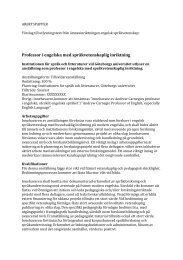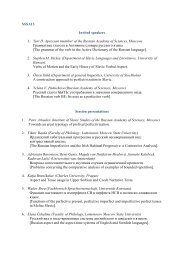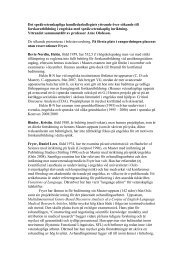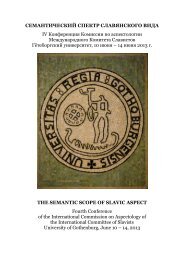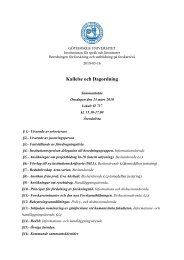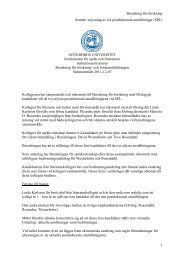listening to and evaluating sounds that influence the intentions of musicians.D. Creative Practices. This means particular approaches to improvisation, composition, etc.,the extent to which material is revised, how it is prepared and developed, mixed and mastered,and so on.E. Receptive Contexts. This includes not only rituals or venues, but also modes of mediationand any combinations with other media, such as drama, dance, or visual image.Clearly, the above categories, despite maintaining integrity in some respects, are most often deeplyintertwined in the context of any genre. Nevertheless, I sense it is possible to identify examples ofmusics that have been mostly “translated” in terms of primary emphasis on a single one or particularcombination of these categories, typically resulting in some form of artistic hybrid or fusion. Ultimately,the usefulness of such a conceptualization will only be recognizable if put into practice, so I willsoon proceed to some concrete illustrations that make use of a template entitled Pentagonal Analysisof <strong>Cultural</strong> Translation (PACT) that was developed to enable this Five Domains of <strong>Cultural</strong> Translationin Music model to be implemented as an analytical tool. I must stress that this model is intended to bemerely interpretative, to guide subjective analysis and stimulate more robust and precise discussion inconversations and debates among both scholars and artists.Applications to JapanThe remainder of this essay will offer consideration of how the aforementioned model maybe applied to specific examples of musicians who are either Japanese or doing work inspired insome way by Japanese cultural traditions, and conclude with some discussion of implications forother domains of cultural translation. It is important to acknowledge that this is by no means thefirst discussion of how westernized music in Japan may be theorized, for there have been verysignificant prior contributions to this theme. 23 However, in terms of how the specific practiceof “musical translation” may be defined, as explained earlier, there are arguably some uniqueaspects to the present discussion. Still, I will begin by briefly describing two of the most interestingprevious models that aim to conceptualize various ways that Japanese musicians have approachedthe mixing of indigenous and western influences, as well as the related role of culturalidentity, in their musical activities, both of which are topics of relevance to the theme of musicaltranslation.Transference, Syncretism, and Synthesis. Music theorist Yayoi Uno-Everett has offered an insightfulmodel in the book Locating East Asia in Western Art Music for interpreting East Asiancomposers’ strategies for constructing hybrid music compositions. 24 This model makes use of thethree categories of: 1) Transference, 2) Syncretism, and 3) Synthesis. According to her conceptualization,within works in the first category (transference), Asian composers: a) “Draw on aes-23 See Yayoi Uno Everett and Frederick Lau, eds., Locating East Asia in Western Art Music (Middleton: WesleyanUniversity Press, 2004), and Gordon Mathews, “Fence, flavor, and phantasm: Japanese musicians andthe meanings of ‘Japaneseness’” Japanese Studies, 24(3) (2004), 335-350. Also, see Bonnie C. Wade, Musicin Japan (Oxford University Press, 2004), and Shuhei Hosokawa, “‘Salsa no Tiene Frontera’: Orquestra de laLuz and the globalization of popular music” 1999, <strong>Cultural</strong> Studies, 13(3), pp. 509-534.24 See Yayoi Uno Everett in Everett and Lau, 2004, p. 16.<strong>Cultural</strong> translation and Music29
thetic principles or formal systems without iconic references to Asian sounds,” b) “Evoke Asiansensibilities without explicit musical borrowing,” c) “Quote culture through literary or extra-musicalmeans,” and d) “Quote preexistent musical materials through the form of a collage.” In thesecond category (syncretism), Asian composers: a) “Transplant East Asian attributes of timbre,articulation, or scale system onto Western instruments” and b) “Combine musical instrumentsand/or tuning systems of East Asian and Western musical ensembles.” In the final category (synthesis),which is presumably least commonly encountered, composers fully “transform” elementsfrom at least two traditions into “a distinctive synthesis.” Yayoi Uno Everett’s model seems particularlyeffective for analysis of the work of composers in the field of art music, for which it wasoriginally designed, and it may also offer some valid applications to other forms of music.Fence, Flavor, and Phantasm. Another interesting metaphorical model is proposed by GordonMathews, who suggests that attitudes toward “Japaneseness” in music be considered in terms oftheir resemblance to the notions of fence, flavor, and phantasm. By “fence,” Mathews means anattitude that promotes “walling off Japanese from change and foreignness,” which he contrastswith both seeing Japaneseness as “a flavor to be enjoyed by anyone in the world,” and as a “phantasm,”by which he means “Japaneseness obliterated, to be created anew if enough people canbe convinced of the validity of such a recreation.” The Fence/Flavor/Phantasm model offers anattractive approach that may be helpful in framing discussions regarding cultural identity in anarray of musics.Despite the apparent utility of these two models, I sense that some Japanese musicians nowadaysmay actually maintain a relatively cosmopolitan and culturally “omnivorous” identity 25 forwhich the very notion of “Japaneseness” and awareness of the Asian origins of musical materialhave little relevance. Shuhei Hosokawa has identified a phenomenon he describes as “the temporarybracketing of ‘identity’ that constitutes the Japanese self” 26 among Japanese musicians,who he recognizes as often capable of maintaining transitory and multi-faceted, or even multiple,musical identities. Both of the aforementioned models may serve as useful tools for grapplingwith how musical sound or cultural identity may be conceived in specific contexts. However,these models may also be sufficiently malleable so as to be considered in combination with othermodels, such as in the Aesthetic Notions domain (zone C) of the Pentagonal Analysis of <strong>Cultural</strong>Translation (PACT) approach developed and applied in this essay for the precise purpose of understandingmusical “translation.”JAPAN IN MUSIC TRANSLATIONI will now proceed to discussion of four examples of contemporary musicians who make varioususes of influences from Japanese traditional culture within their work. For the purpose ofthis essay, I have selected two bands comprised of Japanese musicians who perform in a kind offusion genre – the Yoshida Brothers and Tokyo Brass Style – and two bands comprised of non-Japanese musicians who perform in hybrid styles inspired by Japanese culture: the Helsinki Koto3025 For recent sociological discussion of cultural “omnivorousness” see Koen van Eijck and John Lievens,“<strong>Cultural</strong> omnivorousness as a combination of highbrow, pop, and folk elements: The relation betweentaste patterns and attitudes concerning social integration,” Poetics, 36 (2008), 217-242.26 Hosokawa, 1999, p.526.David G. Hebert
- Page 1: Cultural TranslationsProceedings of
- Page 4 and 5: PrefaceThe idea of organizing a wor
- Page 6 and 7: ContentsAcknowledgementIIPrefaceIII
- Page 8 and 9: Literature and Transculturality:Som
- Page 10 and 11: agenda of Herder, which was to figh
- Page 12 and 13: nomenon. However, until long into t
- Page 14 and 15: Tawada’s work appeared in Swedish
- Page 16 and 17: multiple interpretations. Japan is
- Page 18 and 19: Cultural Translation between Tradit
- Page 20 and 21: George P. Murdock illustrated the p
- Page 22 and 23: ancestor of the Maori arrived in Ao
- Page 24 and 25: nal names do not necessarily have.
- Page 26 and 27: One of the functions of ‘cultural
- Page 28 and 29: PRELUDEIn 2003, an original artisti
- Page 30 and 31: planted, adopted and fused with ind
- Page 32 and 33: liest known written clues regarding
- Page 34 and 35: since there are many Asians and Pac
- Page 38 and 39: Ensemble, and the Moscow Pan-Asian
- Page 40 and 41: temporary Finnish folk music. 29I a
- Page 42 and 43: Although some space for improvisati
- Page 44 and 45: whom have devoted many years to ser
- Page 46: POSTLUDEBy way of conclusion, allow
- Page 49 and 50: IntroductionThe aim of this paper i
- Page 51 and 52: to discuss what role Japan was to p
- Page 53 and 54: I may be allowed henceforth to use
- Page 55 and 56: program was to promote and help stu
- Page 57 and 58: 50different of that of Millán -Ast
- Page 59 and 60: most impracticable people in the ea
- Page 61 and 62: intending to give the Book a quasi
- Page 63 and 64: understood by the West on a time wh
- Page 65 and 66: FUJIWARA Masahiko. (2008) Kokka no
- Page 67: - (2002) Cultural light, political
- Page 70 and 71: Translation, or better, linguistic
- Page 72 and 73: one may not expect anything other t
- Page 74 and 75: as Murakami opts for a globalized v
- Page 76 and 77: market. 17 Another indispensable to
- Page 78 and 79: (This is part of my doctoral thesis
- Page 80 and 81: elieve advances man’s progress he
- Page 82 and 83: ender the New Testament into Japane
- Page 84 and 85: a synonym for kami. The latter is a
- Page 86 and 87:
The American school text is in the
- Page 88 and 89:
Willson Reader 46 T73 47I will not
- Page 90 and 91:
Gentlzer, Edwin & Tymoczko, Maria 2
- Page 92 and 93:
Tea ceremony or tea cult?Translatin
- Page 94 and 95:
Company (VOC), men came from differ
- Page 96 and 97:
H. Stolpe gathered items in Japan f
- Page 98 and 99:
simple presentations had negative i
- Page 100 and 101:
theticism, with its manifold bearin
- Page 102 and 103:
Kumakura, Isao (1980) 近 代 茶
- Page 104 and 105:
1. Introduction and aim of the pape
- Page 106 and 107:
main character and the caller doesn
- Page 108 and 109:
not” and ”at present” that ha
- Page 110 and 111:
match this name, a sea as artificia
- Page 112 and 113:
I John Gabriel BorkmanHenrik Ibsen
- Page 114 and 115:
his dream during the 1870s, when ca
- Page 116 and 117:
make a decision. But it turns out t
- Page 118 and 119:
Ôgai’s change of translation str
- Page 120 and 121:
Behind every utterance lies two mot
- Page 122 and 123:
a large group of persons be gathere
- Page 124 and 125:
The “Territory of Translation”
- Page 126 and 127:
八 十 日 間 世 界 一 周 :
- Page 128 and 129:
heuristic tools, especially conside
- Page 130 and 131:
Left: Photo of Kawashima Chūnosuke
- Page 132 and 133:
Burlington Gardens is in London (Ro
- Page 134 and 135:
門 アリ 入 リテ 見 レバ
- Page 136 and 137:
scene seems to be merely one of man
- Page 138 and 139:
Niwa Jun’ichirō’s Spring Tale
- Page 140 and 141:
The text is full of detailed descri
- Page 142 and 143:
where the narrative voice does not
- Page 144 and 145:
The reason the “territory of tran
- Page 146 and 147:
Translating the Trip Around the Wor
- Page 148 and 149:
ForwordI have been working on my do
- Page 150 and 151:
clining though. By the end of 1980
- Page 152 and 153:
幸 い 神 の 怒 りは 鎮 ま
- Page 154 and 155:
The Public Sphere as Deliberation o
- Page 156 and 157:
and absence of hierarchy would have
- Page 158 and 159:
was used much like we would use “
- Page 160 and 161:
outcasts and bandits - were suppose
- Page 162 and 163:
cal sense, the arena where particip
- Page 164 and 165:
society” and in which “there wa
- Page 166 and 167:
sic formulations, the public sphere
- Page 168 and 169:
はじめに日 本 統 治 下 の
- Page 170 and 171:
似 地 一 下 一 下 拽 那 鼻
- Page 172 and 173:
ということから、 古 丁
- Page 174 and 175:
の「 序 」で、 大 東 亜
- Page 176 and 177:
3.1 翻 訳 と 満 洲 国 語 政
- Page 178 and 179:
取 り 入 れを 主 張 する
- Page 180 and 181:
文 化 の 翻 訳 としての「
- Page 182 and 183:
史 性 にも 留 意 すべきだ
- Page 184 and 185:
て、 渦 巻 きよりほかは
- Page 186 and 187:
変 わらないということも
- Page 188 and 189:
訳 語 と 新 語 から 見 る
- Page 190 and 191:
しは「 無 為 」や「 本 性
- Page 192 and 193:
思 想 を 基 礎 として、
- Page 194 and 195:
って「 物 理 上 哲 学 」
- Page 196 and 197:
し、まさにはこの 時 期
- Page 198 and 199:
意 譯 : 理 學 、 性傅 汛
- Page 200 and 201:
柴 田 昌『 增 補 訂 正 英
- Page 202 and 203:
一 八 七 七 年 、 文 部 省
- Page 204 and 205:
日 中 友 好 の 象 徴 「 鑑
- Page 206 and 207:
と 指 摘 した。成 吉 思
- Page 208 and 209:
をあげている。さらにま
- Page 210 and 211:
に 請 ひて 出 家 を 求 む
- Page 212 and 213:
この 時 奉 請 の 十 師 等
- Page 214 and 215:
歴 史 小 説 『 天 平 の 甍
- Page 216 and 217:
点 」が 生 じたと 指 摘
- Page 218 and 219:
まず、 昨 今 、 活 発 に
- Page 220 and 221:
2、 従 来 の 比 較 文 学 (c
- Page 222 and 223:
普 遍 理 論 を 適 用 し、
- Page 224 and 225:
ス・テグネル(Esaias Tegnér,
- Page 226 and 227:
に 満 ちる「 生 命 」に
- Page 228 and 229:
う 形 をとって 展 開 した
- Page 230:
学 が 大 学 で 展 開 して



